- Compact style
- Indico style
- Indico style - inline minutes
- Indico style - numbered
- Indico style - numbered + minutes
- Indico Weeks View
PS/SPS User Meeting
PS-SPS Users Meeting for Week 21 held on May 23rd, 2024
Physics Coordination schedule:
- May 19th to June 9th: Martin Jäkel
- June 10th to June 20th: E. Barbara Holzer
- June 21th to July 7th: Martin Jäkel
- July 8th onwards: E. Barbara Holzer
June 13th: User meeting exceptionally on zoom only (for availability of the conference room).
News from the PS & SPS Physics Coordinator (E.B. Holzer, M.R. Jäkel)
Today beam stop 13h30 for ≈ 30 minutes.
LINAC4, to change a power supply in one klystrons.
-
User Schedules v2.0.1 (for most of the lines until end of August) released: see User Webpage
-
Please get in contact, if you want to take one of the week still free before June - Tanja (tetiana.shulha@cern.ch) is collecting all requests. Newly available : Week 22 in H2. (In parallel with NA64, high energy hadrons and low energy electrons (< 120 GeV/c) of good quality)
-
2024 injector schedule released EDMS 2872566
2024 approved LHC schedule EDMS 2872429
Proton Run 2024
- AD/ELENA Physics Stop Monday 02.12.2024
- SPS NA Physics Stop protons Thursday 31.10.2024
- PS EA Physics Stop protons Wednesday 27.11.2024
Ion Run 2024
- SPS NA Physics Start 4.11.2024 (maybe earlier if set-up is fast) - Stop Pb ions Monday 2.12.2024 (6h)
- NA : Week 45-47 high energy
- NA : Week 48 low energy (no LHC running)
- PS EA Physics Start 6.11.2024 (tbd) - Stop Pb ions Monday 2.12.2024 (6h)
- CHIMERA: 13.11-2.12
Reminder: All beam time exceeding the limits of 2 weeks PS beam time and 1 week SPS beam time (added proton and ion beam time!) per year need the approval of one of these CERN committees: SPSC, LHCC, DRDC, INTC, RB or IEFC. Consider joining a DRD collaboration, if you require more beam time.
News from the Facilities Operations Meeting (FOM) (M.R. Jäkel)
Upcomming MDs:
- Week 21: Dedicated SPS MD 22/5 (crystal shadowing) with beam extracted to North Area --> no access to ECN3
- Week 22: Dedicated SPS MD 29/5 (COLDEX, no extraction to TT20) --> access to ECN3 possible
- Week 23: no dedicated MDs (because of LHC MDs).
Upcoming Techncial Stop
- 12-15.06 : Intervention on Swiss power network. (Planed to finish Friday, with Sat. 15.06 as overflow day)
- Not the main supply for CERN, but electrical pertubations (high harmonic distortions) likely. Risk of trips on SVCs and filters for LHC and injectors.
- TI will confirm the end of the interventions and give go-ahead for restart
PS Machine Report (A. Lasheen)
Good availability since last Thursday (94%)
- Important issues on all beams reported on Wed 15.05
- Root cause of the issue remains unclear, large variations in orbit already from injection propagating later during the cycle.
- Sudden change, appearing from one supercycle to the next, also linked to change in PSB-PS energy matching
- All beams brought back to operational conditions on Thu 16.05
- Beam prepared for EAST T9 with longer spill at 15 GeV
- Issues with RF systems overnight Mon-Tue and Tue (broken power supplies) swiftly fixed by RF experts
SPS Machine Report (F.M. Velotti)
- Good availability except for long stop needed to fix long-standing issue on Cavity 1
- Issues started a few weeks ago and believed we could have made it to ITS1
- Finally on Saturday, avalanche of sparks in C1 could not be stopped and stop was needed
- Intervention started on Saturday evening and finally solved completely on Sunday afternoon
- No issues since then. Now back to settings just before the issues started and coherent with all other cavities
- ZS realigned together with crystal to keep loss at extraction as low as possible
- Intensity adjusted slightly to increase intensity on T10
- AWAKE: started on Monday as soon as beam was available, with still not optimal beam parameters
- Finally on Tuesday RF experts looked into details at the delivered bunch length and managed to optimize it by changing the voltage balance on cavity 3 and 1 to get back more power on C1 and reduce a bit the load on C3 (limited)
- Yesterday dedicated MD for fixed target beam fully completed and access given to NA62 before and after the MD on TT20
- Today long parallel MD for LHC beams until 18:00
- Stop at 13:30 for about 30 min from LINAC4
- Short parallel MDs on Friday again
Safety (A. Schouten)
- General reminder for PPE compliance and ISIEC requests.
nToF (M.Bacak and P.M.Milazzo)
Smoothly data taking.
- EAR-1: Ce(n, f) with PPAC detector
- EAR-2: 146Nd(n, g) with STED
- NEAR: Issue with the HPGe detector in activation measurement
Beam in stable conditions: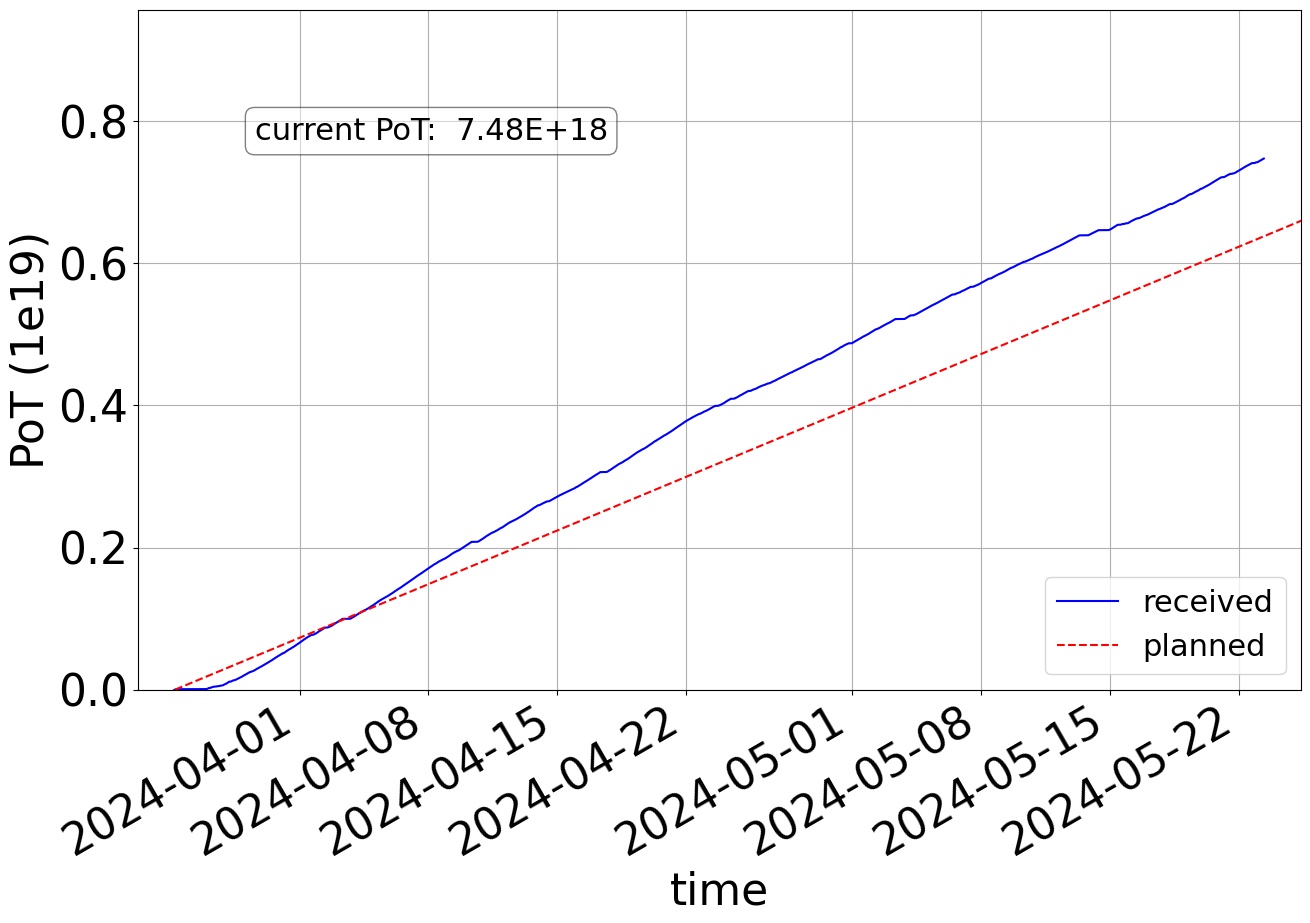
East Area Beam Status (N. Charitonidis)
General: First tests done with 15 GeV/c protons to T09 target and 0.8 s flat top. Many thanks to BE-OP for their help and support. Will need one day to test this down to the experimental areas.
T09: Good operation for HERD. Beam set up for VLAST this morning.
T10: Good operation.
T11:
East Area Users Tour de Table
T8 Main: IRRAD/CHARM (F. Ravotti / S. Fiore)
Regular user operation. Good week, cumulated ~2.4e16 p/w on T8 as on W19, see plot below. We reduce intensity on Monday morning to test cool-down scheme for CHARM. Beam slighly off center on the X-axis during long weekend (center within +/- 2mm ~60% of the time). Very good on Y-axis:

Access during Wednesday morning. In IRRAD removed the TE-CRG experiment, all other long-term experiments continue while preparing new samples for ATLAS-HGTD. In CHARM two experiments removed (BE-CEM and half of TE-MPE), the others continue for this week. We continue until next Wednesday.
T9 Outgoing Main: RE44 HERD (Cong Dai)
-
Successfully completed our expected test items.
energy scan dE/dx scan 1-5 GeV/c e- 1-5 GeV/c e- position scan energy scan (π+/π-/μ+) 3 GeV/c e- 5, 10, 15 GeV/c -
The PS beam was stable last week, with a total of about 1 million valid events acquired (triggered area with 4 cm×4 cm).
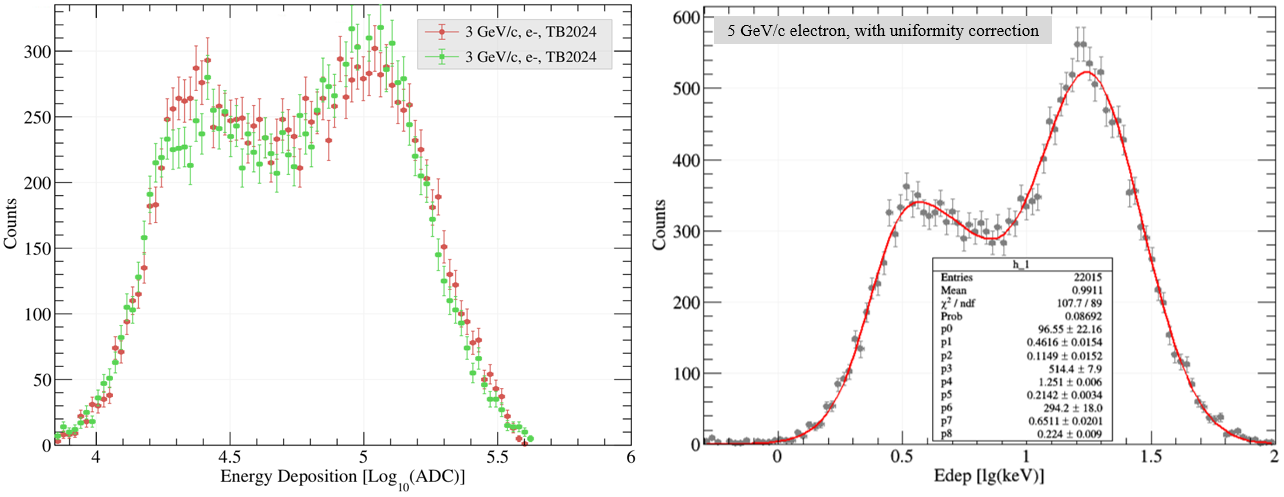
-
We completed the uninstall of the equipment on 21 May, and radiation protection already completed.
Many thanks to the beam operators and physicists.
T9 Main: VLAST (LI Xiang)
The detector setup is OK. Dipanwita is now helping us tuning the beam. Normal data taking should start soon.
T10 Outgoing Main: ALICE ITS3 (Paolo Martinengo)
Test successfully completed, deinstalled yesterday morning as planned
No issues to report, beam was just fine
T10 Main: EIC DRICH (Please Put Your Name Here)
North Area Beam Status (N. Charitonidis)
H2: Smooth operation.
H4: Smooth operation.
H6: Beam set up for high intensity with the longer target in T4. No issues.
H8: Good operation. Hadron beams set up for ATLAS TileCal with new tertiary optics, looking forward to feedback.
M2: Good operation. Quad9 fluctuations caused some trips. EPC changed the regulation card yesterday but the fluctuations remain. To be followed up.
P42/K12: Smooth operation.
Incoming: AWAKE (Please put your name here)
North Area Users Tour de Table
P42-K12:
Main: NA62 (Phil Rubin for Alina Kleimenova)
Thank you for providing 20-21 units on T10, as requested, for generally good beam quality and availability, and for the heroic work recovering RF cavity 1.
Reminder: Because we are very sensitive to beam quality (instantaneous rate), we appreciate your patience for and quick response to our request(s) to remove spikes in the flat-top.
Access to the experimental area during beam time was required to fix two detector problems and so TI could replace a broken network switch (D900-1V-IP504-SHPBL-1).
This morning, between 6:30 and 8:30, a faulty hydrogen gas leak detector caused the experiment to lose about 2 hours of data due to interlocks on the CEDAR HV. The leak detector is now bypassed, and some intervention will be necessary to fix or replace it or the interlock system.
M2:
Main: AMBER (Thomas Poschl)
- Commissioning of lH target ongoing
- safety visits for clearance currently ongoing
- depending on readiness of PLC system, plan to start cool-down and filling over weekend or beginning of next week
- empty-target measurements with spectrometer ongoing
- jumps of Quad09 several times crashed DAQ due to sudden increase of beam intensity in M2 (see attached figure of example from yesterday jump at around 20:00). First intervention and change of regulation card did not resolve the issue
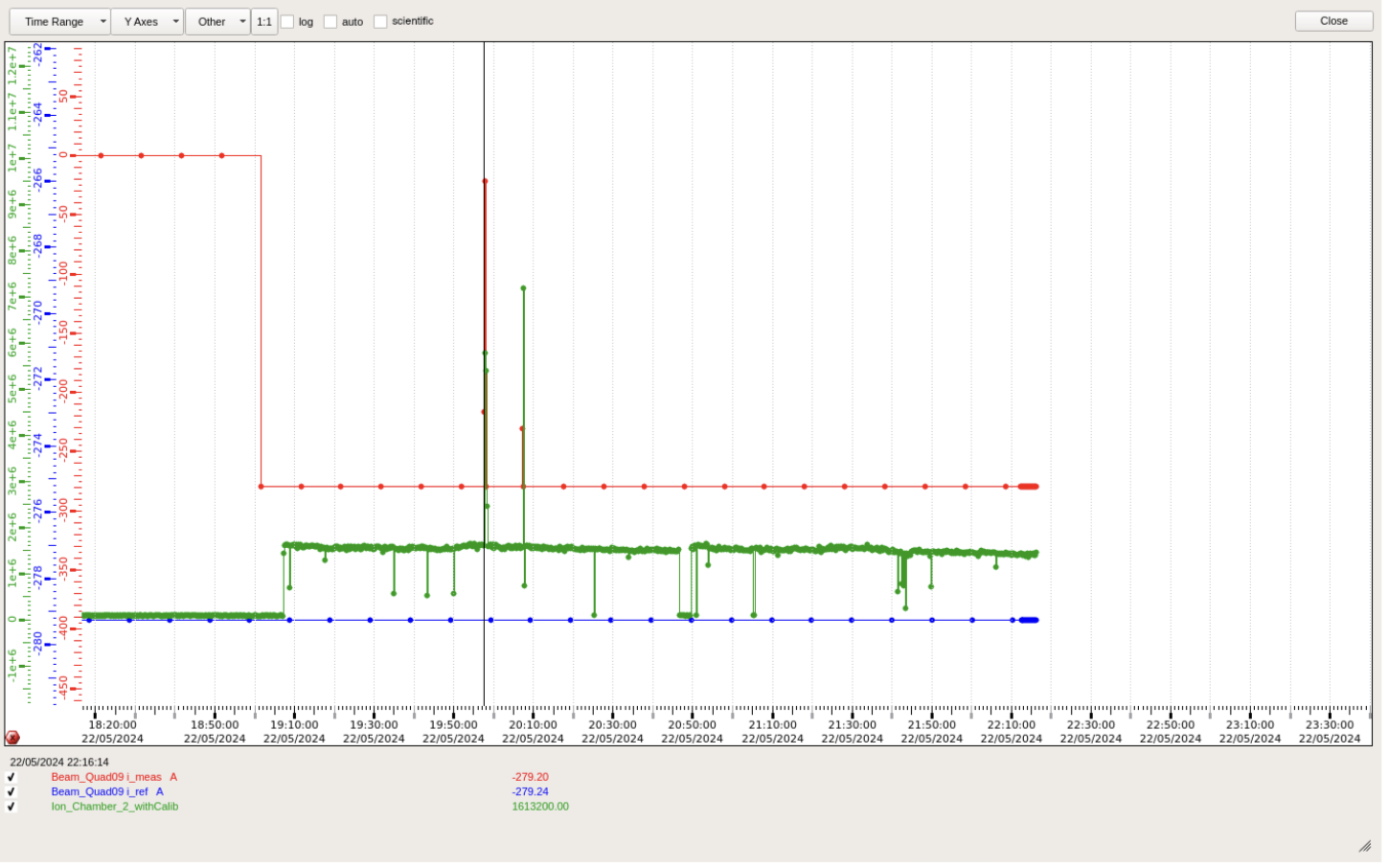
H2:
Outgoing Main: VLAST (LI Xiang)
We’ve performed some test using muons, electrons and hadrons.
We tested the response of multiple gains/channels of our detector, inspect the back-splash effect induced by electrons (indicating gamma-rays), and the direct ionization effect to APD chips.
Here are some very priliminary (deposit) energy responses for 50 GeV, 100 GeV and 140 GeV electrons (though not pure).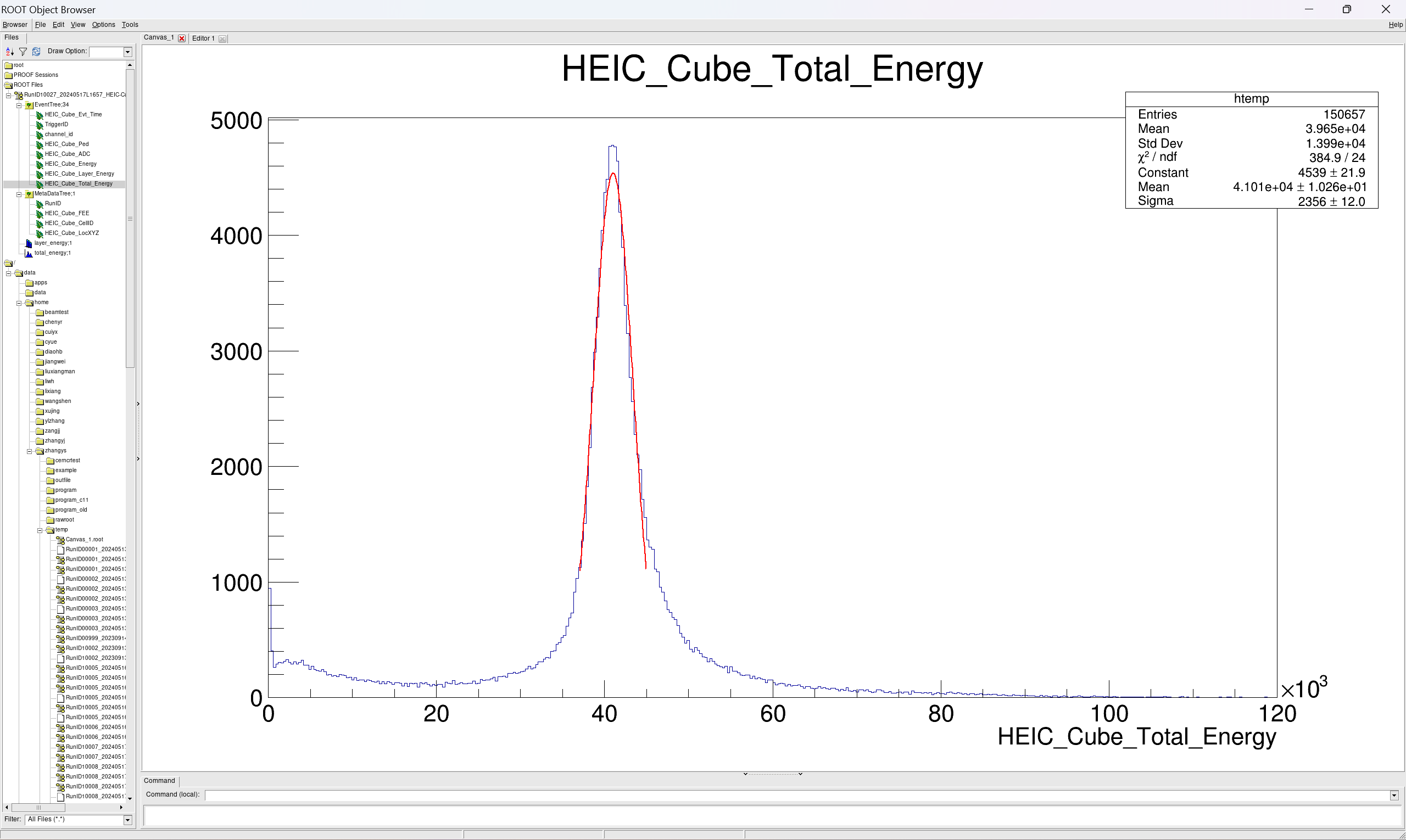

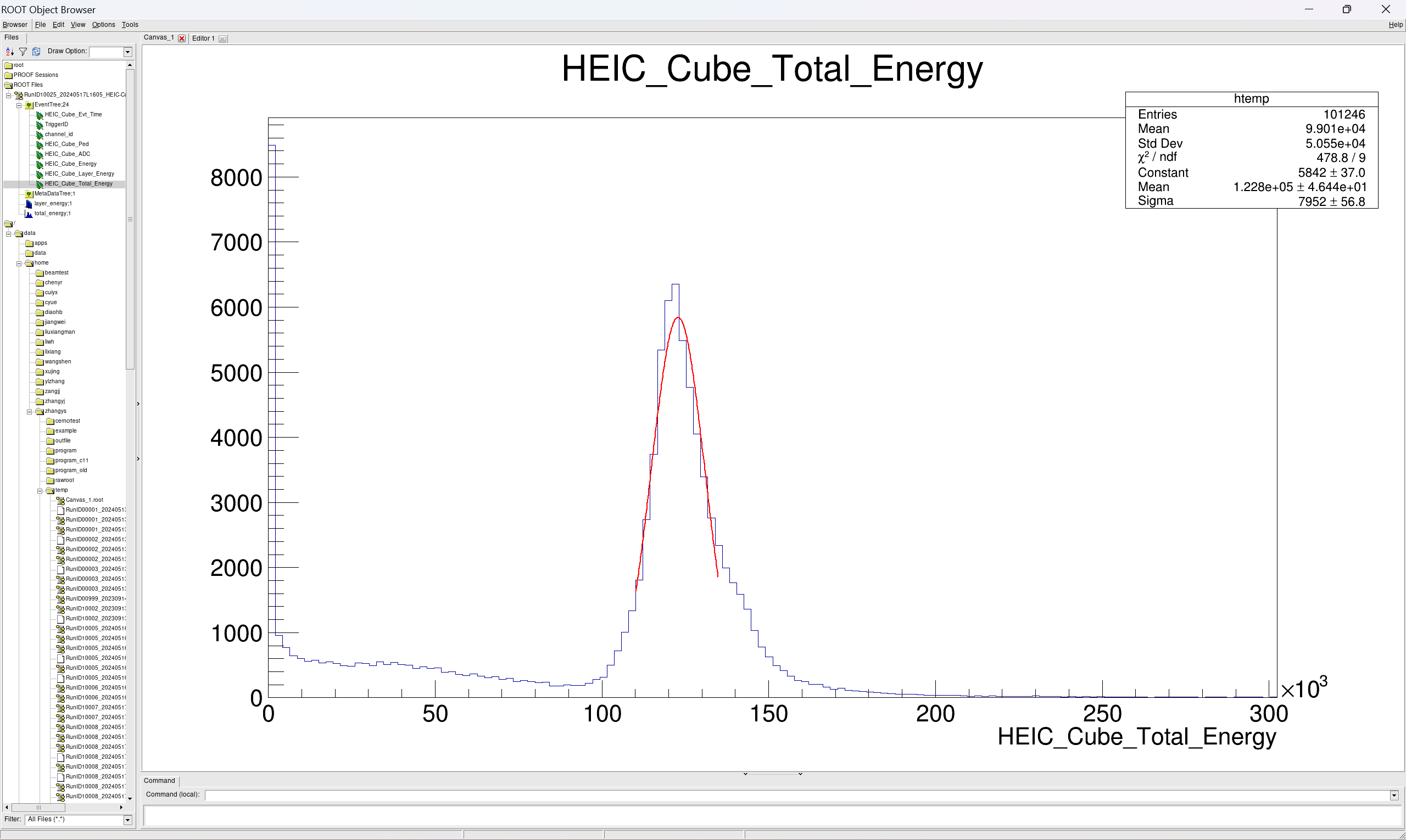
More detailed analyses on the back-splash effect and APD-direct signals are still ongoing.
Thanks Nikos and Michael for the support during out beam test.
Main: ALICE FOCAL (Please Put Your Name Here)
H4:
Main: NA64e (Vladimir Poliakov)
Smooth data taking, except 18 and 19 May, when SPS was OFF. We are accumulated around 2.1x10^11 EoT and recorded 51K spills.
Intensity test with 100 units on T2. The data was recorded with intensity: 6.5x10^6, 8.5x10^6, 9.4x10^6, 10.0x10^6, 11.0x10^6, 12.6x10^6.
There are reasonable beam quality up to 12.6x10^6 and very nice up to 10.0x10^6. Thanks to the BE-EA group, in particular Nicos, Sylvain, Bastian and Michael.
H6:
Outgoing+Incoming Parallel: ATLAS HGTD (Week 22) (Andre Rummler)
As far as I know successful data taking with ASIC in cold state. Cold box has been cleared and telescope/FEI4 switched off but support equipment stayed there for the continued data taking in one week time.
Outgoing Parallel: ATLAS ITK PIXEL (Andre Rummler)
A lot of data recorded with one unirradiated RD53B single chip module using the BDAQ readout with eudaq2/tlu2 feeding the tlu clock into BDAQ to time align. Timing has to be analyzed; some ideas to improve timing for next time. Data taking was stable. Beam was good. Setup has been removed leading the AIDA telescope with PI stage in nominal configuration. Telecope/FEI4 have been switched off.
Main: EP PIXEL (Younes Otarid)
Thank you to Dipanwita for the effort to realign the beam
Very satisfied with the beam
Smooth data taking
Incoming Main: CMS PIXEL (Week 22) (Branislav Ristic)
CMS Pixel will start detector production this year. We’ll test production prototypes with close-to-final readout chips that were irradiated to end of life fluences: efficiency, positional resolution, different read-out modes.
Setup as usual:
- AIDA telescope for tracking
- Own DUT box with C6F14 chiller
- HV up to 600V
- 120 GeV/c π+
beam with rather low intensity (~5kπ
- /spill)
H8:
Outgoing Main: LHCB (Federico Ronchetti and Ettore Zaffaroni)
- Installed and run with EPFL SciFi telescope and long fibre mat.
- Since we were able to handle high rate and thanks to Maarten for high quality beam, we managed to finish all the measurement in few days of data taking.
- Smooth operation thanks to nice communication with the other user upstream on the line (UA9).
- Yesterday we removed the setup.
Main: ATLAS TILECAL (G.Usai and T. Mkrtchyan)
Apologies for missing the meeting today!
The installation of new electronics was completed and setup moved into the area.
Safety inspection in the afternoon and clearance for beam received.
We are iterating with technical team for finalising/checking the routing of one Cherenkov counter that seems missing.
The requested beam files/settings were prepared and tested by Maarteen late in the evening. Many thanks Maarteen!
Testing the table movement we realised a small mechanical part
connecting the encoding of the angular position to the computer controlled movement system was damaged.
We are trying to repair it with help from the ATLAS TC team. In the worst case scenario the rotations can be performed by experts and position monitored manually with laser system. All other movement are monitored/controlled by the SW.
We plan calibration scan with Cesium this afternoon/evening, and should be ready to start the Run program tonight or tomorrow.
Thanks to all the CERN personnel of NA for the help in the setup, in particular Michael and his teams and Maarteen.
Parasitic Users
H8 Outgoing: UA9 (Francesca Galluccio)
The run went quite smoothly; easy collaboration with the other users on the line.
We took lots of data with the TimePix3 with the crystal in different positions.
We finished the commissioning of the hardware of the new tracker configuration.
Yesterday we moved the detector out of the line and we’ll be back in 3 weeks.
Thanks to Maarten and Dipanwita for being ready to help at all times.
Thanks to CCC operators for help in opening/closing the zone, and putting the line on standby.
We should be reviewed at the IEFC on May 31st.
H6: RE1 AMS L0 (M. Duranti - INFN Perugia)
- still in stable data taking, up to 29.
- main goal of the BT is to fully characterize the “bias resistor” region:
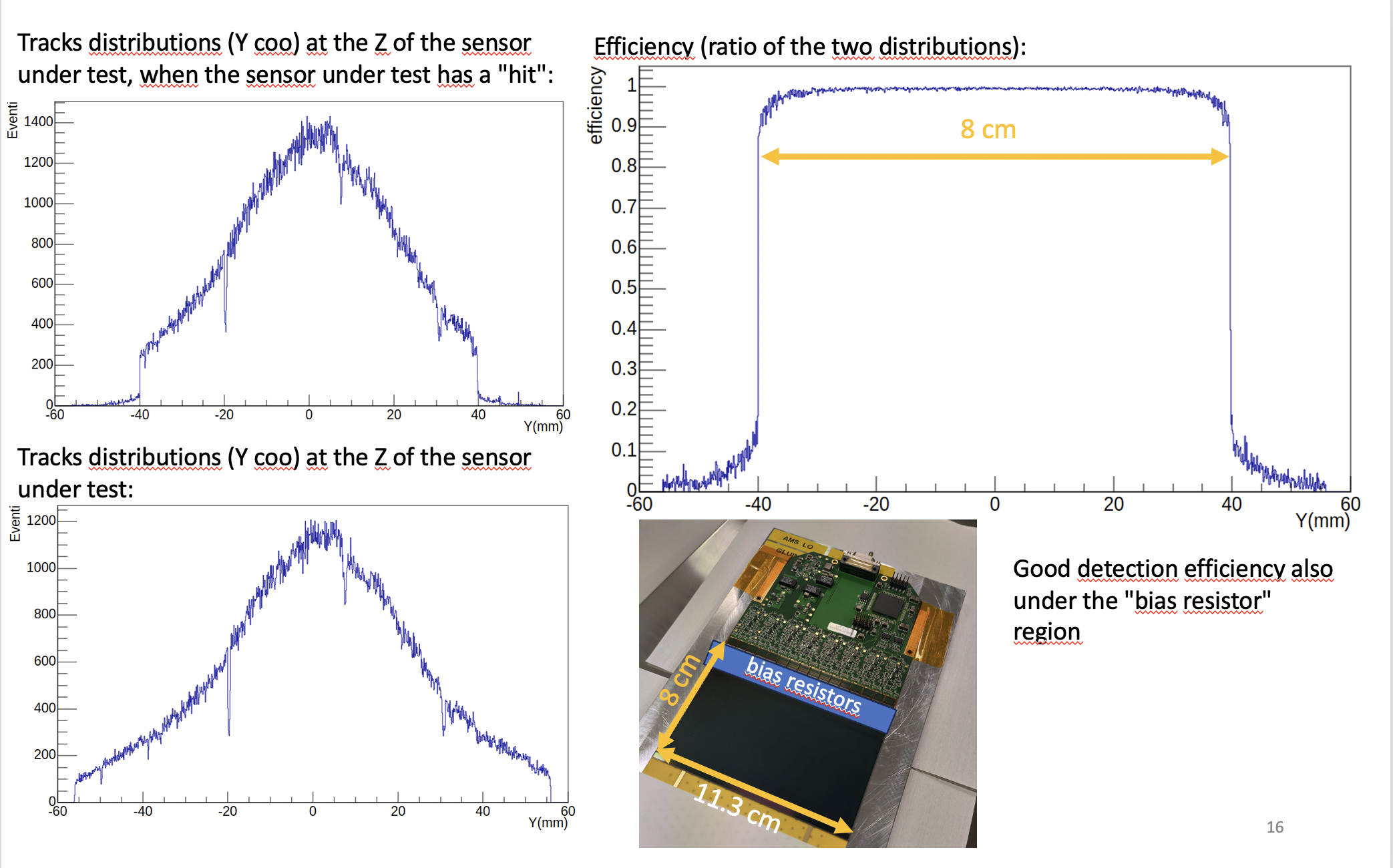
(the efficiency of the sensor is very high also in the bias resistor region)
H6: MONOLITH (Please Put Your Name Here)
H6: ATLAS MALTA (Please Put Your Name Here)
H8: STRAW TRACKER RD (Please Put Your Name Here)
AoB
Minutes by the respective speakers, edited by E. B. Holzer, M. Jäkel, T. Shulha, and M. Schwinzerl
There are minutes attached to this event.
Show them.
